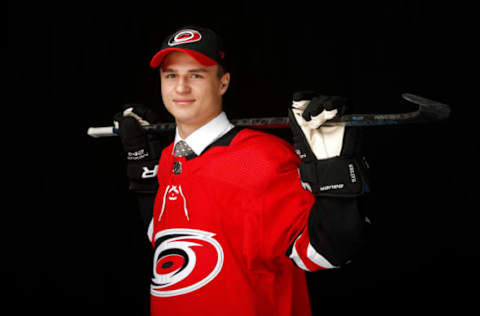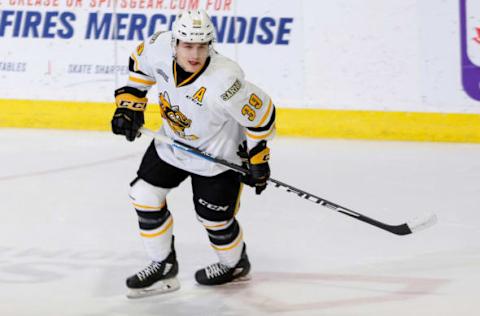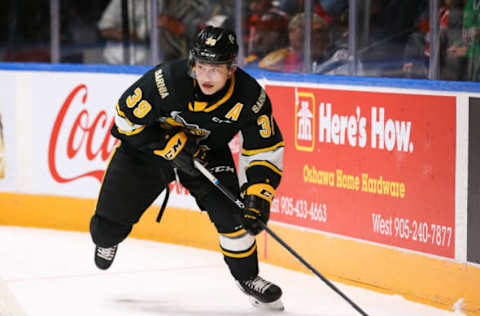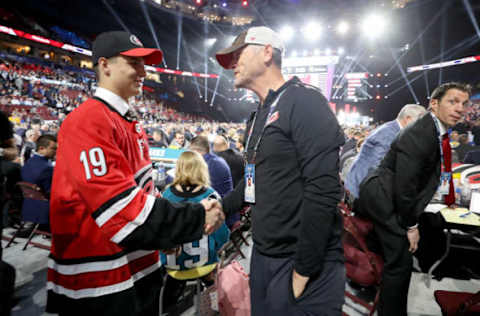Carolina Hurricanes: Jamieson Rees Prospect Profile


I know this isn’t really my first article here at Cardiac Cane, but since the first two were just a game preview and recap, we’re going to go ahead and pretend like it is.
If you know me at all, or at least follow me on Twitter, you know this is the most on-brand introductory article I could possibly write.
Prospect tracking and scouting are some of my favorite parts of my sports fandom. It has been that way for years, and definitely isn’t partial to hockey. There is just something exciting about watching young players get drafted into the leagues they have dreamed of and worked toward for years, then continuing to develop their game in order to break through into that league.
More from Analysis
- 2023 Southeast Rookie Showcase: Takeaways from the Canes’ Strong Showing in Florida
- Week Two Coverage Of College Hockey In NC
- The Southeast Rookie Showcase Will Be a Good Look at Carolina’s Future
- Noesen Ready To Provide Depth For Canes
- Kids Canes: Shut Outs Stop Them All!
This is why, for myself as well as many of my friends in the Canes and hockey coverage community, this current era of the Carolina Hurricanes franchise is like a long Christmas morning. Not only is the current NHL product absolutely electrifying with its young talent, but the pipeline is stacked with players that could keep this team in contention for the foreseeable future.
This brings us to my favorite of all those prospects I have tracked over the years: the pesky but incredibly talented forward, Jamieson Rees.
Rees is currently – and temporarily – playing for the AHL’s Chicago Wolves, alongside fellow top prospects Ryan Suzuki and Seth Jarvis (as well as Nashville’s Philip Tomasino). He has provided flashes that show why he is a highly-regarded prospect, but also shown some rough edges – which should be expected from a player that isn’t actually eligible to play in the minors for another year.
In this post, we’ll take a look at how he got here, break his game down in-depth as I’ve seen it over the last couple of years, and consider what his future has in store from a ceiling and floor standpoint.

Career to Date
Rees, a native of Hamilton, Ontario, began to turn heads in the widely-renowned Greater Toronto Hockey League, one of the largest youth hockey pipelines of future-NHL talent on the planet (seriously, the GTHL’s alumni list is pages long of current and former NHL players). Playing for the Mississauga Reps U16 AAA squad, Rees led his team with an impressive 24 goals and 40 points in 32 games in 2016-17. He then tacked on six goals and five assists in 11 OHL Cup games with the club.
This was enough to get him drafted ninth overall in the 2017 OHL Priority Selection by the Sarnia Sting – and, incidentally, two of the players drafted ahead of him are still his organization-mates in Ryan Suzuki (first overall, Barrie) and Blake Murray (seventh overall, Sudbury).
Rees would get his first taste of OHL hockey the following season (2017-18), coming onto the scene with a rock-solid age-16 season, netting five goals and 20 points in 46 games, largely in a depth role. He also played for the Canada Black squad at the 2017 WHC U17s, where he had a goal and four points in five tournament games.
Big things were expected from Rees in the OHL ahead of the 2018-19 season, especially with his first year of NHL Entry Draft eligibility the ensuing June. Unfortunately, his season ended up being a bit of a disappointment. Rees plays an extremely physical, in-your-face style that caused him to miss over 30 games due to injury (a lacerated kidney kept him out of the Sarnia lineup for about two months) and suspension (a high hit earned him an eight-game suspension). When he was on the ice he was inconsistent, spending much of the year trying to get his feet under him, and finished with just 32 points (10 goals, 22 assists) in 37 games.
Despite the tough regular season, Rees was afforded a chance to make up for lost time playing for Team Canada at the U18 World Championships; he did not disappoint. He finished fourth in scoring on a stacked roster (12 players on the team were first-round picks) with two goals and eight points in seven games and showed he was not out of place amongst elite prospects. The tournament definitely propelled him up some teams’ draft boards, and most ranking services had him anywhere from the late first round to early in the third.
The Carolina Hurricanes believed in his game enough to take him in the 2nd round, 44th overall.
This brings us to last season – the breakout where things finally seemed to come together at the major junior level. Rees was named Sarnia’s alternate captain before the season started, and came out absolutely on fire. Although he again dealt with suspensions and a minor injury that caused him to miss 23 games, Rees was one of the deadliest players in the OHL, scoring 18 times and adding 43 assists in 39 games played. The 1.56 points-per-game clip was the 11th-best rate in the OHL.
And, finally, Rees was one of the last cuts from Team Canada’s U20 World Juniors roster, despite notably sticking out in the pre-tournament exhibitions and practices.

Jamieson Rees, the Present: Scouting Report
As previously mentioned, with the CHL not playing during the pandemic and the current agreement in place temporarily allowing players under the age of 20 to suit up in the AHL, Rees is getting some invaluable ice time playing for the Chicago Wolves. He has certainly made an impact, notably in a recent one goal, one assist, five shots-on-goal game against Rockford.
However, he has just one assist six shots on goal in the five other games he’s played combined. He hasn’t been consistent with his impact, despite showing the talent and skillset needed to do so.
So, what are those attributes that we want to see out of him consistently, on a nightly, gamely, shift-ly basis?
Rees’ game starts with something simple: he plays the game of hockey hard. When on his game, he’s impossible not to notice; be it flying in on the forecheck, finishing an opponent with a heavy hit, or generally being a nuisance and incredibly difficult to play against. This may be mildly surprising at first glance; Rees is only listed at 5’10 and 182 pounds, a frame that would generally suggest he’s a finesse player. But you would be wrong, as Rees is effectively a small-packaged power forward.
He’s an excellent skater, not only in terms of pure speed but also in his agility, acceleration, and footwork. This allows him to fly all over the ice and stay in the opponents’ faces for what seems like all 60 minutes of each game. He also has a great balance that he uses to ward off checks, protect the puck, and deliver huge hits himself (seriously though, he hits everything that moves).
Now, when I start a scouting report talking about work ethic and physicality, you may think I’m beginning to describe a Warren Foegele or Brock McGinn-type that projects to a bottom-six, a player that creates energy, and you likely would not rely upon for offensive production. Once again, you would be wrong. The thing that makes me so high on Rees, and so excited for his future within the Carolina organization, in particular, is the high-end skill and playmaking that he brings along with the edge in his game.
Rees has some of the smoothest hands in our system, giving him the ability to operate in tight quarters and put defenders on highlight reels with dekes. He is electric with the puck on his stick, with great pace and the ability to make plays at full-speed.
In the aforementioned Rockford game, both of his points that day came on similar power moves that showed this skill. He uses his speed to break wide into the attacking zone before cutting to the middle, keeping the defender on his hip to protect the puck, then uses his quick hands to get a chance on goal. Seth Jarvis knocked in the rebound on one play:
This is the prequel to "Seriously, @_jamiesonrees?"@Canes#CHIvsRFD #WeAreTheWolves pic.twitter.com/k75ttmxVoT
— Chicago Wolves (@Chicago_Wolves) February 7, 2021
And Rees was able to deke around the Rockford netminder and bury it on the other:
Seriously, @_jamiesonrees.@Canes#CHIvsRFD #WeAreTheWolves pic.twitter.com/wADchNguJW
— Chicago Wolves (@Chicago_Wolves) February 6, 2021
Rees’ vision is another standout area of his game. He certainly leans more towards playmaking than finishing. He hits cross-seam passes with regularity, especially on the powerplay, and always seems to know where every player is on the ice. It’s a lot of fun to watch him get to work on a forecheck, force a turnover, and quickly spin and find a teammate for an out-of-nowhere grade-A chance.
That’s not to say he will not create for himself and score his fair share of goals. As previously mentioned, he has a multitude of moves in his bag, and his junior highlight reel is full of end-to-end carries where he dangles multiple players and finishes. While not a pure sniper with a wicked release or heavy velocity, he has a great offensive IQ that allows him to find soft spots in the defense and bang home rebounds or receive high-danger passes, and he does have the accuracy on his wrist and snapshots to pick corners with regularity.
What a move, what a goal 😱🐝🚨#NHLDraft prospect @_jamiesonrees has scored in three-straight for @StingHockey but none greater than this #BestOfOHL 🎥 pic.twitter.com/OhhSRbPRmR
— Ontario Hockey League (@OHLHockey) December 15, 2018
Defensively, Rees already has a very good understanding of positioning and support, and consistently battles in the defensive zone to win possession and get the puck moving up ice. He was a penalty-killing mainstay – and oh, by the way, five of his 18 goals came shorthanded in 2019-20, the fourth-best mark in the OHL – so he can be trusted to play in all situations. He’s fantastic in board battles as well, simply the type of player that you can start in the defensive zone, and even if your team loses the draw, you can count on him winning it back and that shift ending on the other end of the ice.
While he’s largely played center in juniors and was drafted as a center, because of how stacked the Carolina Hurricanes’ prospect pool is there I’m not sure he stays down the middle in the NHL. Some scouts seem convinced that position difference can make a break a player’s value, but Rees, to me, will be effective wherever you put him. On the wing, he can mostly focus on getting in on the forecheck and creating havoc, but will still have ample opportunity to carry the puck for zone entries and exits, another area he excels at.
Now, as high as I am on the kid, there are legitimate concerns. We have already touched on the injury woes he has sustained already, and with his frame that will always be a concern. But you don’t ask a kid like Rees to dial back that sort of style because of how imperative it is to his toolkit, he simply has to learn to pick his spots and protect himself as much as possible – especially once he gets to the NHL, when the grind (and the hits) get that much harder, playing 82 games against grown men.
And as has been outlined above, Rees has a reputation already as a player that sometimes gets close… well, just full-on crosses the line. High and blindside hits have been his biggest issue, and something he absolutely has to rein in to survive in the NHL. Not only will he put a target on his back that will put himself at injury risk, but teams don’t want to employ a player that constantly puts them down a man or is suspended.
Other than that, the only real concern in his game is his occasional tunnel vision. He can try to do too much with the puck, then get lost in a crowd and turn it over. He has a ton of confidence in his hands, for good reason, but with his fantastic playmaking ability, he needs to use his teammates a little more often – especially once he gets to the NHL level. Those plays where he tries to dangle three guys, while beautiful when they work, won’t succeed nearly as often once he turns pro. Give it to your teammate and you’ll get it back soon enough.
These aren’t end-of-the-world red flags, and, frankly, are all things that can be corrected. Some concerns to have with a young, skilled player can be quite damning like work ethic, skating, or defensive ineptitude. But ‘maturity’ and game reps are needed for a 19-year-old? That sounds… normal.
Overall, Rees’ toolkit is extremely impressive and suggests he will be able to help an NHL team in a multitude of ways.

Future Outlook
While his development has been extremely promising, Rees has only played an additional 45 games since being drafted. He is still pretty raw and simply needs game reps to continue learning how to play off his teammates better and develop the mental side of the game.
With that said, I still don’t think Rees is far off from being NHL-ready. He’ll likely spend 2021-22 in Chicago, learning how to play with and against men and not rely so much on his pure talent. However, if he continues to light up the OHL this spring in his final stint there, then translates seamlessly to the AHL with a full NHL training camp under his belt, I wouldn’t be surprised to see him get a call-up at some point in the later stages of next season, either.
Stylistically speaking, Rees has a chance to be the Carolina Hurricanes version of Brad Marchand – again, stylistically. No, I don’t expect him to be one of the deadliest scorers in the league for half a decade. But he plays with that same edge and peskiness that will make his teammates and Canes fans adore him, and opponents will absolutely hate suiting up against him. Another great comparison would be Travis Konecny or Nazem Kadri (shoutout to @CanesProspects and @FutureCanes on Twitter for the comps), as players that are a tad undersized but possess a ton of skill and make plays inside the dirty areas.
Worst case, you’re getting a speedy energy player in your bottom six that flashes skill and secondary playmaking. Best case, this is easily a top-six player (probably more second-line than first, but the way Rod balances his lines what’s the difference anyway?), capable of scoring around 20 goals and 55 or more points depending on how he is deployed. Should his development continue on its current trajectory, that may even be a tad light.
Jamieson Rees is a great fit for the modern NHL. The Carolina Hurricanes’ recent draft strategy under Don Waddell has focused on skill and speed, which is how the NHL has shifted for over a decade now. Rees is an exciting example of that, one of many examples that should continue to supplement a blossoming franchise with young, cost-controlled (about to be very important over the next few years with some extensions that are on the horizon) talents.
With his great work ethic and coachability, Rees will spend the next couple years ironing out the kinks under the player development staff and head coach Rod Brind’Amour. After that, look out – and expect him to play a big role in the future of the Carolina Hurricanes.
Trending. Carolina Hurricanes: The David Ayres Game, 1 Year Later. light